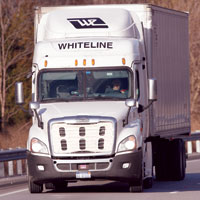For-Hire Trucking Adds 3,000 Positions
This story appears in the Nov. 14 print edition of Transport Topics.
For-hire trucking followed the nation as a whole, adding jobs in October, according to the latest report from the U.S. Department of Labor.
The department’s Bureau of Labor Statistics said Nov. 4 that 1,463,900 people worked in for-hire truck transportation during October, up 3,000 people on a seasonally adjusted basis from September. In October 2015, the employment level for trucking was 1,456,000.
Bob Costello, chief economist of American Trucking Associations, said trucking employment has not been in sync lately with the national pattern.
 John Sommers II for Transport Topics
John Sommers II for Transport Topics “Trucking really hasn’t [been] following the broader employment numbers this year,” he said.
“For example, total nonfarm [employment] is up 1.8%, year to date, while private sector only is up 2%,” Costello said. “Conversely, trucking is up just 0.4% year to date — much weaker, which makes sense given the softness of freight.”
Several related sectors in ground-based freight also posted employment gains in October: Couriers and messengers were up 1,500 workers from the previous month to 632,100; warehousing and storage had a 3,300 gain to 873,900 employees; and rail transportation inched up by 400 workers to 216,700.
For the transportation and warehousing sector, in total, October employment rose by 7,500 people to 4,919,400, BLS said.
Nationally, nonfarm employment rose by 161,000 people for the month, seasonally adjusted to 144.95 million. A year ago, the employment level was 142.6 million, based on the BLS survey of employers.
In a separate survey of households over a similar time, the bureau said the nation’s unemployment rate dipped back to 4.9% in October from 5% the previous month. The rate also was 5% in October 2015.
The civilian labor force participation rate dipped slightly to 62.8% in October from 62.9% the previous month.
The employment level at Trans-Wood Carriers Inc. in Omaha, Nebraska, has been holding steady in recent months, company President Brian Wood said.
“We’re all hiring,” Wood said of his firm and other tank truck carriers. “But the problem has been that attrition has been about equal to hires.”
Drivers make up about 70% of his estimated 800 employees, not including 300 owner-operators.
Wood also is chairman of the National Tank Truck Carriers trade group. Tank carriers try to get experienced drivers because they often haul hazardous materials that require extra care, he said.
Wood’s company, for instance, transports chemicals, petroleum, compressed gases and dry bulk materials. “We tend to avoid people right out of driving schools,” he said.
“It’s hard to find qualified [drivers]. You hire one, but then another one goes to another company or retires,” Wood said of the staffing chase.
The upcoming federal rule requiring electronic logging devices has not been an issue for his company, Wood said. “Most tank truck car- riers are already using them,” he said.
Sleep apnea has been an issue, though. Wood said one of his drivers recently was told by a medical examiner to get tested for sleep apnea, and the driver refused.
“He decided to leave the industry,” Wood said. “It’s another addition to the requirements and regulations.”

